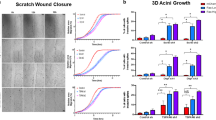Abstract
Resistance to the growth inhibitory effects of TGF-β is common in human cancers1,2. However, the mechanism(s) by which tumour cells become resistant to TGF-β are generally unknown. We have identified five novel human genes related to a Drosophila gene called Mad which is thought to transduce signals from TGF-β family members3–5. One of these genes was found to be somatically mutated in two of eighteen colorectal cancers, and three of the other genes were located at chromosomal positions previously suspected to harbor tumour suppressor genes. These data suggest that this gene family may prove to be important in the suppression of neoplasia, imparting the growth inhibitory effects of TGF-β-like ligands.
Similar content being viewed by others
References
Fynan, T.M. & Reiss, M. Resistance to inhibition of cell growth by transforming growth factor-beta and its role in oncogenesis. Crit. Rev. Oncog. 4, 493–540 (1993).
Brattain, M.G., Howell, G., Sun, L.Z. & Willson, J.K., Growth factor balance and tumor progression. Curr. Opin. Oncol. 6, 77–81 (1994).
Hursh, D.A., Padgett, R.W. & Gelbart, W.M. Cross regulation of decapentaplegic and Ultrabithorax transcription in the embryonic visceral mesoderm of Drosophila . Development 117, 1211–1222 (1993).
Sekelsky, J.J., Newfeld, S.J., Raftery, L.A., Chartoff, E.H. & Gelbart, W.M. Genetic characterization and cloning of mothers against dpp, a gene required for decapentaplegic function in Drosophila melanogaster. Genetics 139, 1347–1358 (1995).
Savage, C. et al. Caenorhabditis elegans genes Sma2, Sma-3, and Sma-4 define a conserved family of transforming growth factor beta pathway components. Proc. Natl. Acad. Sci. USA 93, 790–794 (1996).
Kingsley, D.M. TGF-beta superfamily: new members, new receptors, and new genetic tests of function in different organisms. Genes. Dev. 8, 133–146 (1994).
Roberts, A.B. & Sporn, M.B. Physiological actions and clinical applications of transforming growth factor-beta (TGF-beta). Growth Factors 8, 1–9 (1993).
Satterwhite, D.J. & Moses, H.L. Mechanisms of transforming growth factor-beta 1 - induced cell cycle arrest. Inv. Metast. 14, 309–318 (1994).
Massague, J. & Polyak, K. Mammalian antiproliferative signals and their targets. Curr. Opin.Genet. Dev. 5, 91–96 (1995).
Hahn, S.A. et al. DPC4, a candidate tumor suppressor gene at human chromosome 18q21.1. Science 271, 350–353 (1996).
Korenberg, J.R., Chen, X.N., Adams, M.D. & Venter, J.C. Toward a cDNA Map Of the Human Genome. Genomics 29, 364–370 (1995).
Fearon, E.R. et al. Identification of a chromosome 18q gene that is altered in colorectal cancers. Science 247, 49–56 (1990).
Thiagalingam, S. et al. Evaluation of candidate tumour suppressor genes on chromosome 18 in colorectal cancers. Nature Genet. 13, 343–346 (1996).
Rojas, K., Silverman, G.A., Hudson, J.R., Jr., & Overhauser, J. Integration of the 1993-94 Genethon genetic linkage map for chromosome 18 with the physical map using a somatic cell hybrid mapping panel. Genomics. 25, 329–330 (1995).
Schutte, M. et al. DPC4 gene in various tumor types. Cancer Res. 56, 2527–2530 (1996).
Ogasawara, S. et al. Common deleted region on the long arm of chromosome 5 in esophageal carcinoma. Gastroenterol. 110, 52–57 (1996).
Wieland, I. et al. Allelic deletion mapping on chromosome 5 in human lung carcinomas. Oncogene. 12, 97–102 (1996).
Wick, W. Evidence for a novel tumor suppressor gene on chromosome 15 associated with progression to a metastatic stage in breast cancer. Oncogene 12, 973–978 (1996).
Altschul, S.F., Gish, W., Miller, W., Myers, E.W., & Lipman, D.J., Basic local alignment search tool. J. Mol. Biol. 215, 403–410 (1990).
Hillier, L. Generation and preliminary analysis of over 200,000 human expressed sequence tags. Nature (in the press).
Hudson, T.J. . et al. An STS-based map of the human genome. Science 270, 1945–1954 (1995).
Powell, S.M. et al. Molecular diagnosis of familial adenomatous polyposis. N. Engl. J. Med. 329, 1982–1987 (1993).
Leach, F.S. et al. Mutations of a mutS homolog in hereditary nonpolyposis colorectal cancer. Cell 75, 1215–1225 (1993).
Papadopoulos, N. et al. Mutation of a mutL homolog in hereditary colon cancer. Science 263, 1625–1629 (1994).
Schuler, G.D., Altschul, S.F. & Lipman, D.J. A workbench for multiple alignment construction and analysis. Proteins. 9, 180–190 (1991).
Houlgatte, R. et al. The Genexpress Index - a resource for gene discovery and the genie map of the human genome. Genome Res. 5, 272–304 (1995).
Author information
Authors and Affiliations
Rights and permissions
About this article
Cite this article
Riggins, G., Thiagalingam, S., Rozenblum, E. et al. Mad-related genes in the human. Nat Genet 13, 347–349 (1996). https://doi.org/10.1038/ng0796-347
Received:
Accepted:
Issue Date:
DOI: https://doi.org/10.1038/ng0796-347
- Springer Nature America, Inc.
This article is cited by
-
MicroRNA-23a regulates epithelial-to-mesenchymal transition in endometrial endometrioid adenocarcinoma by targeting SMAD3
Cancer Cell International (2016)
-
The revised role of TGF-β in aortic aneurysms in Marfan syndrome
Netherlands Heart Journal (2015)
-
AGR2 is a SMAD4-suppressible gene that modulates MUC1 levels and promotes the initiation and progression of pancreatic intraepithelial neoplasia
Oncogene (2013)
-
SMAD4 - Molecular gladiator of the TGF-β signaling is trampled upon by mutational insufficiency in colorectal carcinoma of Kashmiri population: an analysis with relation to KRASproto-oncogene
BMC Cancer (2010)





